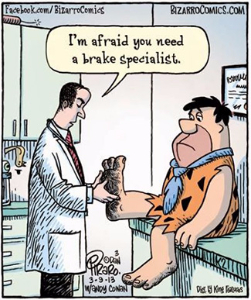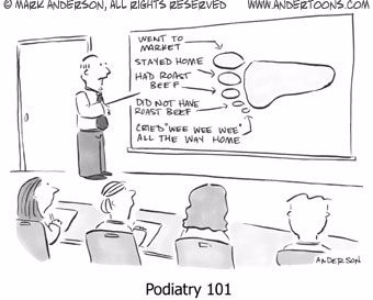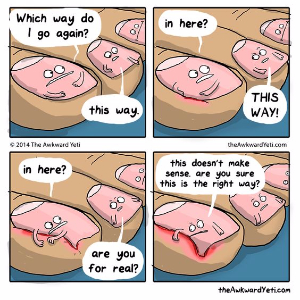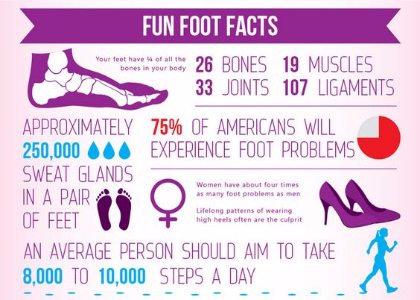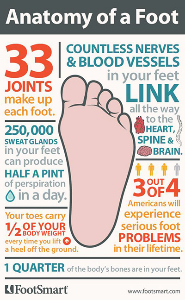Foot Facts
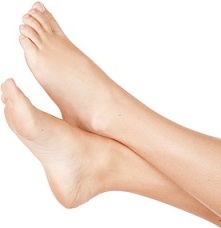
- Seventy-five percent of Canadians will experience foot health problems of varying degrees of severity at one time or another in their lives. About 19 percent of the Canadian population has an average of 1.4 foot problems each year.
- It’s rare that two feet are exactly the same; one of them is often larger than the other and the gait pattern of your right foot does not usually match that of your left.
- If your feet are well-aligned, your toes will point straight ahead when you are walking. The first point of contact is your heel, then the outside border of your foot, then the ball of your foot, and finally the big toe.
- Standing in one spot is far more tiring than walking. The reason for this is that demands are being made on the same few muscles for a length of time.
- When buying shoes, it is a good idea to buy them late in the day, when your feet are tired and may be slightly swollen. It's best to buy shoes that fit your feet under this condition as you are then unlikely to purchase shoes that are too small. Have your feet measured every time you purchase shoes, and do it while you're standing. When you try on shoes, try them on both feet; many people have one foot larger than the other, and it's best to fit the larger one.
- The average person walks up to about 160 000 kilometres, or 115,000 miles, in their lifetime, enough to walk around the earth 4 times. That works out to around 6 and a half kilometres a day.
- While walking, each step can exert a pressure on your feet that exceeds your body weight and when you're running, it can be three or four times your weight -- which adds up to a cumulative force of over 500 tons a day. With certain sporting activities this force can go up to 7 times bodyweight.
- There are about 250 000 sweat glands in the feet. The average person will lose about a cup of moisture a day through the feet.
- The Chinese tradition of the binding the feet of women lasted for 1,000 years from the early 10th century until it was outlawed in 1912.
- Trim your toenails straight across with clippers specially designed for the purpose. Leave them slightly longer than the tips of your toes.
- When walking, each time your heel lifts off the ground it forces the toes to carry one half of your body weight.
- The record for the world’s largest feet belongs to Matthew McGrory who wears US size 28 1/2 shoes. The average men’s size is 10 1/2.
- Fingernails and toenails grow faster during hot weather, pregnancy and teenage years.
- Podiatric physicians are 4 times less likely to use costly services than other physicians
- Your feet mirror your general health. Such conditions as arthritis, diabetes, nerve and circulatory disorders can show their initial symptoms in the feet -- so foot ailments can be your first sign of more serious medical problems.
- In 2016, there were 1100 Podiatrist/Chiropodists actively practicing in Canada. 52% of the Practitioners are in Ontario.
Anatomy
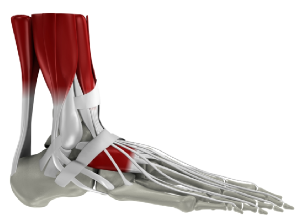
- There are 26 bones in each foot, a total of 52 bones in the both the feet. There are 206 bones in the body which means more than a quarter of all our bones in our bodies are in our feet.
- Thirty-three joints, 107 ligaments, 19 muscles, and tendons hold the structure together and allow it to move in a variety of ways.
- Fourteen of the 26 bones are found in the toes. Each toe has three bones, except the big toe, which has two.
- Achilles, the greatest Greek warrior hero gave his name to the strongest tendon in the body.
- There are more nerve endings per square centimeter in the foot than any other part of the body. Our feet constantly supply us with information about the surface we walk on, without our being even being aware of it. They tell us whether the surface is hot or cold, rough or smooth, which side it slopes to, etc.
- At birth the bones in the foot are mostly cartilage and slowly harden as the foot grows. The bones in the foot will only be completely ossified (hardened) at around 21 years of age.
Skin/Nail Problems

- Corns and calluses are never normal, but they are the most common foot problems. They indicate that you could benefit from foot alignment or from better choice of shoes.
- The skin on your feet is thicker than it is anywhere else on your body.
- When you are stressed, you are more susceptible to the virus that causes warts on the foot.
- Plantar warts are caused by a virus which may invade the sole of the foot through cuts and breaks in the skin. Walking barefoot on dirty pavement or on moist environments can expose feet to this sometimes painful skin infection.
- About 5 percent of the Canadian population has foot infections, including athlete's foot, other fungal infections, and warts each year.
- Heel pain and ingrown toenails are the most common problems researched.
Foot Deformities - Flat feet are not always problematic – if flat feet are well-aligned, they enable a person to stand for longer periods of time, as the weight is distributed over a larger area.
- About 6 percent of the Canadian population has foot injuries, bunions, and flat feet or fallen arches each year.
Diabetes
- 2.3 million Canadians live with diabetes today.
- About 60-70% of diabetics will develop some form of diabetic nerve damage, which in severe forms can lead to diabetic lower limb amputation. Approximately 73,000 people a year lose their foot or leg due to diabetes
- 15% - or 345,000 Canadians – will develop a diabetes foot ulcer in their lifetime.
- Canadians with diabetes are 23 times more likely to be hospitalized for a limb amputation than someone without diabetes.
- 85% of all amputations are the result of a non-healing foot ulcer.
- More than half of amputations these amputations may have been prevented by appropriate footwear and more effective nail and foot care.
- 50% of all lower limb amputations in Ontario are directly related to diabetes.
- An estimated 1,500 Ontarians with diabetes had a limb amputated in 2008.
- 30% of Canadians with diabetes will die within one year of amputation.
- 69% of limb amputees with diabetes will not survive past five years.
- Canadians with diabetes who see their family doctor or health team at least 3 times a year are 33% less likely to have a limb amputation.
- Diabetes foot ulcers cost the Canadian healthcare system more than $150 million annually.
Some of the facts are courtesy of:
Ontario Society of ChiropodistsCanadian Association of Wound CareAmerican Podiatric Medical AssociationCanadian Federation of Podiatric Medicine









